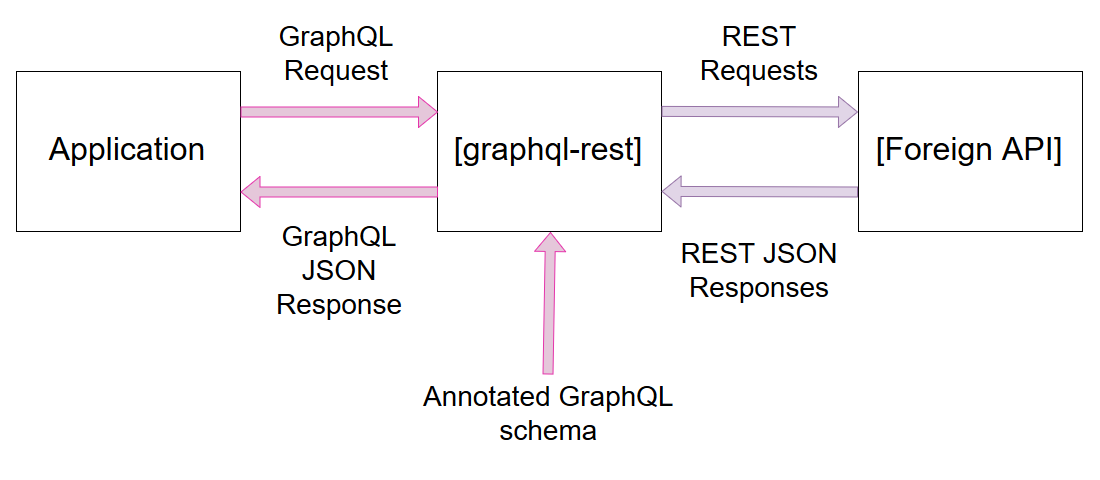graphql-rest v0.0.1-alpha-2
graphql-rest
Because programming with REST APIs is so boringly slow, and because GraphQL APIs are so Great!
This module allows you to GraphQL-ify any (json) REST API by writing only GraphQL. This is possible thanks to GraphQL directives (aka. GraphQL annotations), and made easy to implement by the graphql-tools module from the Apollo GraphQL project.
-- How it works --

1. Add the library to your JS / TS project
With yarn:
yarn add graphql-rest fetch graphqlWith npm:
npm install --save graphql-rest fetch graphqlYou might want to use apollo-server and nodemon for a greater GraphQL development experience. Use one of:
yarn add --dev apollo-server nodemon
npm install --save-dev apollo-server nodemon2. Instantiate GraphqlRest
A. Create mySchema.gql
type Query {
hello: Int
}B. Create server.js
B1. Import the dependencies:
- commonjs style, if you use vanilla node:
const { readFileSync } = require('fs')
const fetch = require('node-fetch')
const { ApolloServer } = require('apollo-server')
const { GraphqlRest } = require('graphql-rest')- es6 style:
import { readFileSync } from 'fs'
import fetch from 'node-fetch'
import { ApolloServer } from 'apollo-server'
import { GraphqlRest } from 'graphql-rest'B2. Start the server:
const PORT = 4000
let myApiGraphqlSchema = readFileSync(`${__dirname}/mySchema.gql`, 'utf-8')
let myGraphqlApi = new GraphqlRest(myApiGraphqlSchema, { fetch })
let { schema } = myGraphqlApi
let server = new ApolloServer({
schema,
})
server.listen({ port: PORT }).then(() => {
console.log(
`Serving the GraphQL Playground on http://localhost:${PORT}/playground`,
)
})C. Run the Apollo Server with nodemon (replace yarn by npm run if you use npm):
yarn nodemon --ext .gql server.jsYou will get an output like:
[nodemon] 1.19.1
[nodemon] to restart at any time, enter `rs`
[nodemon] watching: *.*
[nodemon] starting `node server.js`
Serving the GraphQL Playground on http://localhost:4000/playgroundOpen your browser to http://localhost:4000/playground, where the GraphQL playground runs.
Note: If you are going to be using GraphqlRest in a web browser, consider using node while developing the GraphQL schaema for the API.
3. Develop your annotated GraphQL Schema
mySchema.gql
# This header declares the `from` directive that GraphqlRest implements
directive @from(
"Config"
configUrlBase: String
configQueryStringAdditions: [String]
"Rename a REST result property"
prop: String
"REST calls"
get: String
delete: String
patch: String
post: String
put: String
"Specify a path to the property in the JSON result to use as field value"
root: String
) on OBJECT | FIELD_DEFINITION
# Passing { addHeader: true } allows to omit the header, but is not recommended
# if you are going to use any GraphQL linting tool, as the GraphQL specification
# requires declaring the directives you use
# Using @from(get) allows you to specify the URL and REST method to use for the
# resolver. Any word preceded by `:` will undergo substitution
# A word is /[A-Za-z_]+/
type Query @from(configUrlBase: "https://myApiUrlBase.org/v2/") {
image(id: ID!): Image @from(get: "/:id.json")
user(name: ID!): User @from(get: "/profiles/:name.json")
search(
query: String!
sort: SortFieldInput = created_at
order: SortOrderInput = desc
page: Int = 1
perpage: Int = 15
): SearchPage!
@from(
get: "/search.json?q=:query&sf=:sort&sd=:order&page=:page&perpage=:perpage"
)
}
scalar CommaSpaceSeparatedString
scalar Date
scalar Extension
scalar Mime
scalar Sha512
scalar Url
enum SortFieldInput {
created_at
score
random
}
# Here things get interesting, see the substitution is not only possible with
# GraphQL arguments, but also with the values returned from the REST API call.
# If you are familiar with GraphQL resolvers, here `:uploader_id` is found in
# the `parent` (or `source` ) field of the resolver. This is what enables the
# nesting power of GraphQL
type Image {
representations: Representations
score: Int!
updated_at: Date!
uploader_id: ID
uploader_info: User @from(get: "/profiles/:uploader_id.json")
}
type SearchPage {
search: [Image!]!
total: Int!
}
type User {
id: ID
name: String!
}-- Development --
Done
- Ability to rename a REST property via annotation
- Document the other useful properties of GraphqlRest instances
- Document the lesser useful properties of GraphqlRest instances
- Document the lesser useful features of GraphqlRest schemas
Coming soon
- Mutation queries
- End to end (functional) tests
- Unit tests
- Documented way to use the library outside of development context
- Documented way to make a GraphQL use as a library
- Support for custom annotations with altered behaviour
- Support for GraphQL resolving list types from argument lists stacked type modifier, such as
[[ID]],[ID!],[ID]!,[[[ID!]!]!]! - Ability to specify a property to use in the JSON response rather the JSON root
- Ability to specify a JSON path to a
rootfield in the JSON response - Ability to access JSON nested properties when renaming a property
6 years ago
6 years ago
6 years ago
6 years ago
6 years ago
6 years ago